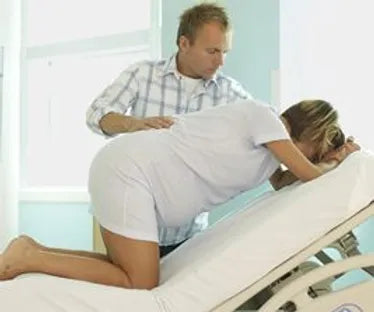Gone are the days when women in labour were instructed to lie flat on their backs, stay put, and get in the stirrups! While this position was fantastic for the delivering doctor (who had easy access and a clear view of the goings-on), it was not so good for mum – who as well as being uncomfortable and humiliated, was strapped in and left to push out baby without the helpful force of gravity.
These days enlightened practitioners, and better-informed expectant women, are no longer taking labour lying down - or even in one place. Instead, mums-to-be are encouraged to labour however they feel comfortable, including changing positions as often as desired. Varying positions often during labour can help speed up the process and ease discomfort.
Keep in mind that a good labour position is one that makes you feel more comfortable for as long as possible. As for delivery; whatever works is the best position for you - your body will clue you in if you listen. Reading up on the different positions ahead of time can help, and even giving them a trial run (but no practice pushing!) before the contractions start hitting.
We outline labour and delivery positions below:
Standing or walking - This technique can relieve some discomfort of labour and works with gravity allowing your pelvis to open and baby to move down the birth canal easier. Walking can help in early labour as a good distractor as well, however as labour progresses the laps of the delivery room are likely to become harder. When your contractions begin to become faster, standing or leaning on your partner or a wall can help. However once delivery begins you will likely need to move into a squat (below).
Squatting - is a great gravity-assisting position you’re likely to use only late in labour or during delivery itself, opening up the pelvis to give your baby more room to move on down. You’ll be pretty wobbly so hold on to your partner or a squatting bar (often attached to birthing bed) for support.
Rocking - either by swaying back and forth, or on a chair, allows your pelvis to move and encourages baby to descend. And the more upright you are, the more gravity is able to help you out. What's more, you can sit in a rocking chair even if you're being monitored continuously.
Birthing balls - are large exercise balls that you can lean on or sit on during labour. Sitting on one helps to open up your pelvis, and it's a lot easier than squatting for long periods. Like squatting, you can use a birthing ball even if you're being monitored.
Sitting - is another one to try, either up in bed, a chair, or your partners arms – and allows gravity to once again assist the process. This position can be assumed even if you've had an epidural or have a fetal monitor strapped on.
Kneeling over a chair - can help you cope with back labour (when the back of the baby's head is pushing against your spine) because it encourages the baby to move forward, taking the pressure off your back. Alternatively, you can lean over your partner's shoulder to relieve some of that pressure.
Hands and knees - is another great position to help ease the discomfort of back labour. This pose (on all fours) can be assumed even if you're attached to a fetal monitor, and allows you to do pelvic tilts for comfort, while giving your partner great access to your back for massage and applying counterpressure. Many women like to deliver in this position no matter what kind of labour they're having, since it opens up the pelvis and uses gravity to help your little one into the world.
Side-lying - can be assumed if you’ve had an epidural, are being continuously monitored, or if you just need to lie down for a while. This is much better than your back as it doesn't compress the major veins in your body (which could compromise blood flow to your baby), and can leave your back open for your partner to massage. Lying on your side can also be a good delivery position — it can help slow a too-fast birth (yes, there is such a thing), as well as ease the pain of some contractions.

